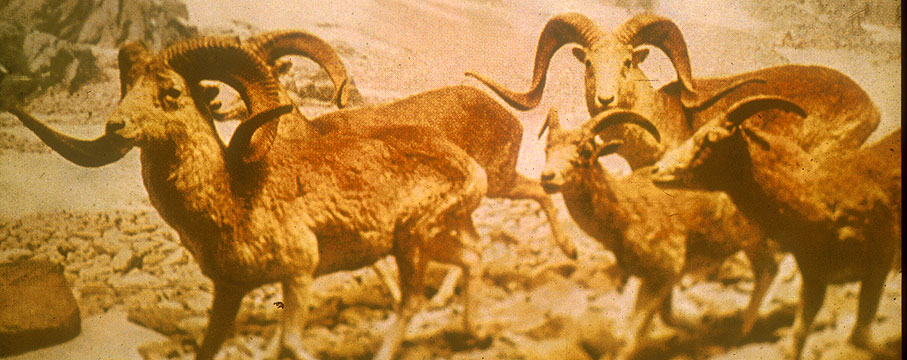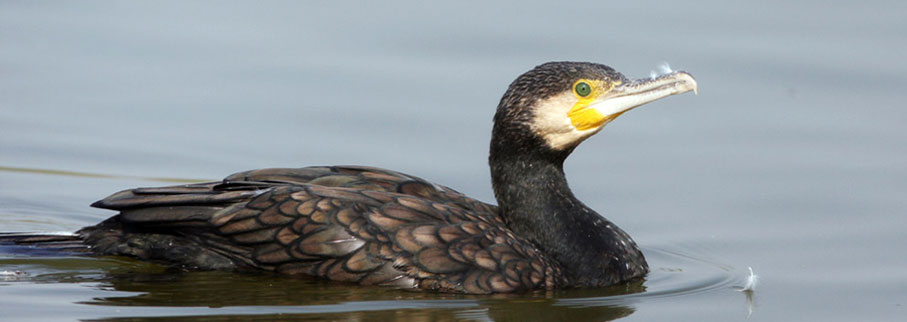Others Concern Species
Chiltan Markhor
The endemic Chiltan markhor (Capra falconeri) is now found only in the Hazarganji-Chiltan National Park, Balochistan. In collaboration with the provincial government, WWF-P has prepared a comprehensive management plan for conserving biodiversity in the Hazarganji-Chiltan National Park.
The plan lays a special emphasis on improving the status of the Chiltan markhor and proposes that additional populations be re-established in suitable habitat. To ensure financial sustainability of the conservation efforts, a trust fund will be established.

Marco Polo sheep
Marco Polo sheep (Ovis ammon) have a scattered distribution in the Karakorum Mountain Range and Hindu Kush. In Pakistan, they are mostly found in the Khunjerab National Park and adjoining areas. The sheep have an endangered status and their numbers have been rapidly decreasing in the last two decades. WWF-P plans to improve the status of Marco Polo sheep through the implementation of the Khunjerab National Park management plan, reduction of grazing pressure in Karchanai Nalla, improvement of watch and ward mechanisms, updating the population statistics, and identification of additional sites where Marco Polo sheep occur.

Migratory Birds
Chitral, in the North West Frontier Province, is on the migratory route or flyway of several globally important bird species. About 20% of approximately one million migratory birds passing through Chitral fall prey to hunting. WWF-P initiated efforts to reduce the hunting pressure in 1992. Awareness and education efforts proved quite successful when, in addition to reduced local hunting, communities also started establishing private bird refuges. The next phase of the project will develop formal conservation guidelines for these bird refuges and build the capacity of the locals to manage them effectively. In addition, WWF-P will continue the mobilisation of communities to establish private bird refuges, facilitate the establishment of conservation associations, establish nature clubs in high pressure hunting areas and enhance environmental awareness.

Punjab Urial
The Salt Range, which is the primary habitat of the Punjab urial, is facing rapid degradation. Primary among these threats are activities, such as exploitation of mineral reserves and widespread poaching, for economic and sustenance reasons. Efforts to improve the status of the Punjab urial depend on assessing the nature and extent of the threats, and on involving major stakeholders in the conservation efforts. WWF-P aims to take this approach in its efforts to save the urial, by determining the current distribution and health of habitats, identifying existing and potential threats and working with the stakeholders to implement measures in conserving this endangered ungulate. The establishment of adjoining conservancies in the urial's home range will be a major part of the project.

Woolly Flying Squirrel
Local sightings of the endemic Woolly flying squirrel (Eupetaurus cinereus), once thought to be extinct, provided the impetus for undertaking initial surveys to verify its presence in the Northern Areas of Pakistan. The surveys not only confirmed the presence of this species, but also indicated viable population levels. WWF-P has established the ecological status of the Woolly flying squirrels and has also identified critical habitat areas in the Sai valley. Surveys will be extended to other parts of the Northern Areas and Chitral. In addition, WWF-P aims to help ensure the survival of the squirrels by facilitating the notification of a Protected Area for them and undertaking local awareness programmes.

Cranes
Siberian, Sarus, Demoiselle, and Common Cranes
Out of the four crane species found in Pakistan, Siberian cranes (Grus leucogeranus) are rare and seldom seen. The status of Sarus cranes (Grus antigone) is vagrant. They have been locally extinct as breeding birds since 1968. Demoiselle cranes (Anthropoides virgo) are seen quite often on migration, but are ruthlessly hunted in the Bannu District, NWFP. Common cranes (Grus grus) are scarce and there are no permanent wintering populations. They are not often seen, even on migration. Efforts to protect these cranes and their important staging and breeding habitats in Pakistan will include identification of critical sites for each species, mobilisation of communities in protection, development and dissemination of conservation educational material in crucial hunting areas, and establishment of private crane refuges.

Marbled Teal
The Marbled teal (Marmaronetta angustirostris) is one of Pakistan's five resident duck species. It has an endangered status, but information on its population and local migration patterns is inadequate, as surveys have been limited to the Punjab. WWF-P plans to establish the status of Marbled teal in other provinces, before developing a national recovery plan to protect the Marbled teal and its crucial wetland habitat.

White-Headed Duck
Wintering populations of the globally significant white-headed duck (Oxyura leucocephala) have decreased significantly in number during the last few years, with only an estimated 50 birds remaining. Wintering sites in Pakistan are limited to three adjoining wetlands, known as the Ucchali Complex in Punjab.
Balochistan Black Bear
WWF-P aims to assist the Balochistan Government to establish a Protected Area for the Balochistan black bear, and to prepare a recovery plan. This endemic sub species is faced with severe hunting pressure and serious habitat loss. A WWF-P preliminary survey in part of the Phub Range of Balochistan indicated the presence of only a few animals. Conservation efforts in this phase will entail establishing the population status and threat levels, identifying the core habitat, collecting relevent socio-economic and ecological data and proposing feasible recommendations.

Western Tragopan
The most elusive of Pakistan's pheasants is the Western tragopan (Tragopan melanocephalus). Although they were once common in the Western Himalayas, only a small population now survives in Keyal and Palas valleys, in Indus Kohistan, and in Azad Kashmir. The species is classified as threatened with extinction. Like other tragopans, Western tragopan pheasants have richly patterned and spotted plumage, with contrasting areas of bare skin around their throats and eyes. Comparatively, little is known about these shy and nervous birds, which live in inaccessible, high-altitude areas. Although attempts have been made at capturing these elusive birds since 1837, a captive breeding programme has never been established. The survival of the Western tragopan depends on protecting their habitat.

Musk Deer
About the size of a large thin labrador, musk deer (Moschus chrysogaster) have speckled coarse fur and short stumpy tails. Their legs are longer at the back than the front. Adult males have prominent downward curving canine teeth, an unusual feature for a member of the deer family. Although they are known to survive in the the Machiara and Neelum valleys in Azad Kashmir, in the Gilgit area and the Palas Valley, Musk deer have become extremely rare. People trap and kill them to obtain a valuable pod containing musk which is sold for use in perfumes. Although trade in musk is controlled by the Convention on International Trade in Endangered Species (CITES), enforcement is difficult and the survival of musk deer are in doubt.
